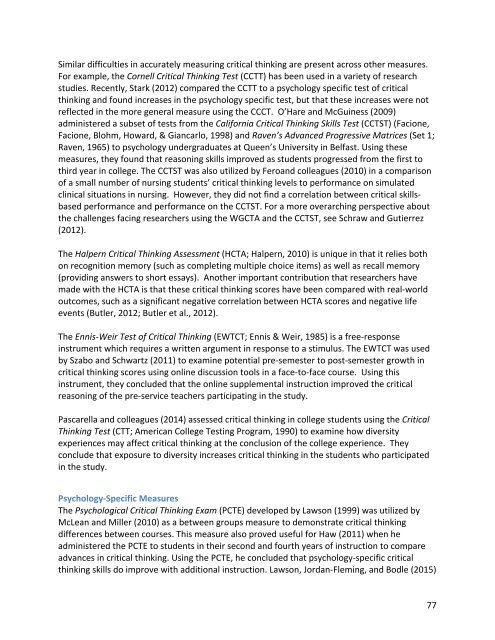A COMPENDIUM OF SCALES for use in the SCHOLARSHIP OF TEACHING AND LEARNING
compscalesstl
compscalesstl
You also want an ePaper? Increase the reach of your titles
YUMPU automatically turns print PDFs into web optimized ePapers that Google loves.
Similar difficulties <strong>in</strong> accurately measur<strong>in</strong>g critical th<strong>in</strong>k<strong>in</strong>g are present across o<strong>the</strong>r measures.<br />
For example, <strong>the</strong> Cornell Critical Th<strong>in</strong>k<strong>in</strong>g Test (CCTT) has been <strong>use</strong>d <strong>in</strong> a variety of research<br />
studies. Recently, Stark (2012) compared <strong>the</strong> CCTT to a psychology specific test of critical<br />
th<strong>in</strong>k<strong>in</strong>g and found <strong>in</strong>creases <strong>in</strong> <strong>the</strong> psychology specific test, but that <strong>the</strong>se <strong>in</strong>creases were not<br />
reflected <strong>in</strong> <strong>the</strong> more general measure us<strong>in</strong>g <strong>the</strong> CCCT. O’Hare and McGu<strong>in</strong>ess (2009)<br />
adm<strong>in</strong>istered a subset of tests from <strong>the</strong> Cali<strong>for</strong>nia Critical Th<strong>in</strong>k<strong>in</strong>g Skills Test (CCTST) (Facione,<br />
Facione, Blohm, Howard, & Giancarlo, 1998) and Raven’s Advanced Progressive Matrices (Set 1;<br />
Raven, 1965) to psychology undergraduates at Queen’s University <strong>in</strong> Belfast. Us<strong>in</strong>g <strong>the</strong>se<br />
measures, <strong>the</strong>y found that reason<strong>in</strong>g skills improved as students progressed from <strong>the</strong> first to<br />
third year <strong>in</strong> college. The CCTST was also utilized by Feroand colleagues (2010) <strong>in</strong> a comparison<br />
of a small number of nurs<strong>in</strong>g students’ critical th<strong>in</strong>k<strong>in</strong>g levels to per<strong>for</strong>mance on simulated<br />
cl<strong>in</strong>ical situations <strong>in</strong> nurs<strong>in</strong>g. However, <strong>the</strong>y did not f<strong>in</strong>d a correlation between critical skillsbased<br />
per<strong>for</strong>mance and per<strong>for</strong>mance on <strong>the</strong> CCTST. For a more overarch<strong>in</strong>g perspective about<br />
<strong>the</strong> challenges fac<strong>in</strong>g researchers us<strong>in</strong>g <strong>the</strong> WGCTA and <strong>the</strong> CCTST, see Schraw and Gutierrez<br />
(2012).<br />
The Halpern Critical Th<strong>in</strong>k<strong>in</strong>g Assessment (HCTA; Halpern, 2010) is unique <strong>in</strong> that it relies both<br />
on recognition memory (such as complet<strong>in</strong>g multiple choice items) as well as recall memory<br />
(provid<strong>in</strong>g answers to short essays). Ano<strong>the</strong>r important contribution that researchers have<br />
made with <strong>the</strong> HCTA is that <strong>the</strong>se critical th<strong>in</strong>k<strong>in</strong>g scores have been compared with real-world<br />
outcomes, such as a significant negative correlation between HCTA scores and negative life<br />
events (Butler, 2012; Butler et al., 2012).<br />
The Ennis-Weir Test of Critical Th<strong>in</strong>k<strong>in</strong>g (EWTCT; Ennis & Weir, 1985) is a free-response<br />
<strong>in</strong>strument which requires a written argument <strong>in</strong> response to a stimulus. The EWTCT was <strong>use</strong>d<br />
by Szabo and Schwartz (2011) to exam<strong>in</strong>e potential pre-semester to post-semester growth <strong>in</strong><br />
critical th<strong>in</strong>k<strong>in</strong>g scores us<strong>in</strong>g onl<strong>in</strong>e discussion tools <strong>in</strong> a face-to-face course. Us<strong>in</strong>g this<br />
<strong>in</strong>strument, <strong>the</strong>y concluded that <strong>the</strong> onl<strong>in</strong>e supplemental <strong>in</strong>struction improved <strong>the</strong> critical<br />
reason<strong>in</strong>g of <strong>the</strong> pre-service teachers participat<strong>in</strong>g <strong>in</strong> <strong>the</strong> study.<br />
Pascarella and colleagues (2014) assessed critical th<strong>in</strong>k<strong>in</strong>g <strong>in</strong> college students us<strong>in</strong>g <strong>the</strong> Critical<br />
Th<strong>in</strong>k<strong>in</strong>g Test (CTT; American College Test<strong>in</strong>g Program, 1990) to exam<strong>in</strong>e how diversity<br />
experiences may affect critical th<strong>in</strong>k<strong>in</strong>g at <strong>the</strong> conclusion of <strong>the</strong> college experience. They<br />
conclude that exposure to diversity <strong>in</strong>creases critical th<strong>in</strong>k<strong>in</strong>g <strong>in</strong> <strong>the</strong> students who participated<br />
<strong>in</strong> <strong>the</strong> study.<br />
Psychology-Specific Measures<br />
The Psychological Critical Th<strong>in</strong>k<strong>in</strong>g Exam (PCTE) developed by Lawson (1999) was utilized by<br />
McLean and Miller (2010) as a between groups measure to demonstrate critical th<strong>in</strong>k<strong>in</strong>g<br />
differences between courses. This measure also proved <strong>use</strong>ful <strong>for</strong> Haw (2011) when he<br />
adm<strong>in</strong>istered <strong>the</strong> PCTE to students <strong>in</strong> <strong>the</strong>ir second and fourth years of <strong>in</strong>struction to compare<br />
advances <strong>in</strong> critical th<strong>in</strong>k<strong>in</strong>g. Us<strong>in</strong>g <strong>the</strong> PCTE, he concluded that psychology-specific critical<br />
th<strong>in</strong>k<strong>in</strong>g skills do improve with additional <strong>in</strong>struction. Lawson, Jordan-Flem<strong>in</strong>g, and Bodle (2015)<br />
77


